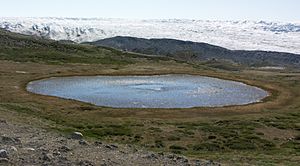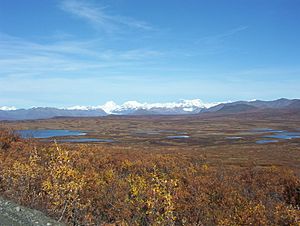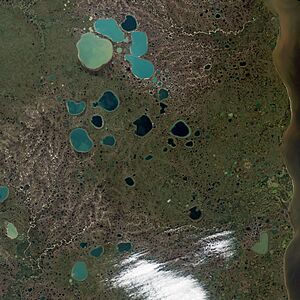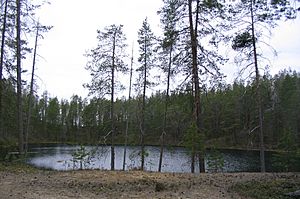Pothole (landform) facts for kids
Potholes (also known as kettles or kettle holes) are shallow areas of water. They are often filled with sediment, which is like dirt, sand, and small rocks. These interesting landforms are created when large glaciers melt and retreat, or sometimes by powerful floods.
Imagine a giant block of ice breaking off a glacier. This block might get covered by the dirt and rocks that the glacier leaves behind. When the ice block finally melts, it leaves a hole in the ground. This hole is what we call a pothole or kettle.
Potholes can also form when a lake that was held back by ice suddenly drains. As the ice melts, natural walls, called ramparts, can form around the edges of these holes. The lakes that fill these holes are usually not very deep, often less than 10 m (33 ft). Over time, they slowly fill up with sediment. If the water is acidic, a bog might form. If it's more alkaline, it could become a peatland.
Contents
What are Kettle Holes?
Kettle holes are special landforms made by melted water from glaciers. This process is sometimes called "fluvioglacial." When the weather gets warmer, glaciers start to melt. Big pieces of ice can break off, a process called "calving."
Instead of melting right on the surface, these ice blocks can get partly or completely buried. They get covered by dirt, rocks, and plant material. This material is called "sediment" and it's carried by the glacier. This sediment builds up on the land where the glacier used to be. This flat, wide area is known as an "outwash plain."
A kettle hole forms when a buried ice block melts. The ground above it then sinks, creating a dip or hole. Many kettle holes can form close to each other. With the ridges and mounds of sediment around them, the flat outwash plain becomes bumpy and uneven. Kettle holes can also appear in piles of loose rocks called "till."
How Floods Create Kettles
Kettle holes can also form when a large amount of ice blocking a lake's exit suddenly breaks apart. This causes a huge flood, known as a "jökulhlaup" (an Icelandic word). These floods can carry blocks of ice and sediment, similar to how glaciers drop them.
Scientists have studied how these floods create kettle holes. They found that protective walls, or ramparts, often form around the edges of kettle holes made by jökulhlaup floods. The type of ramparts that grow depends on how much rock is in the melted ice and how deep the ice block was buried.
Size of Kettle Holes
Most kettle holes are less than two kilometers wide. However, some in the central United States can be more than ten kilometers across! Puslinch Lake in Ontario, Canada, is the biggest kettle lake in Canada. It covers about 160 hectares (400 acres). Fish Lake in Washington state, USA, is also large, at 200 hectares (490 acres).

Most kettles are less than ten meters deep. Over time, kettle holes usually fill with water, sediment, or plants.
- If a kettle gets more water from rivers or streams, it becomes a kettle lake.
- If it gets its water mainly from rain, snow, or groundwater, it's called a kettle pond.
- A kettle wetland is a kettle pond where many plants grow.
Some kettle ponds dry up during warm summer months. These are called "ephemeral" ponds because they disappear on their own for a while.
Kettle Bogs and Peatlands
If the water in a kettle becomes acidic, usually because of decaying plant material, it can turn into a kettle bog. However, if the soil underneath contains lime, which helps balance the acid, it might become a kettle peatland instead.
Kettle bogs are like closed ecosystems. They only get water from rain and snow. Both acidic kettle bogs and fresh water kettles are important homes for many different kinds of plants and animals that depend on each other.

The Kettle Moraine is a region in Wisconsin, USA. It stretches from Green Bay to south-central Wisconsin. This area has many kettles, along with other features left by glaciers. Some of its kettle lakes are very deep, reaching 100 feet (30 m) to 200 feet (61 m).
Kettle Point in Ontario, Canada, has rock formations that locals call 'kettles'. However, there are no actual kettle lakes in that specific area.
Examples of Kettle Regions
The Prairie Pothole Region is a vast area that goes from northern Alberta, Canada, down to Iowa, United States. It has thousands of small, shallow bodies of water and lakes. These are often called "sloughs" and are found in wetlands.
Related pages
- Glacial landforms
- Pond
Images for kids
-
River Orchy, Scotland, showing erosion potholes in bedrock.
-
The "pot that washes itself" located just south of the village of Canajoharie.





